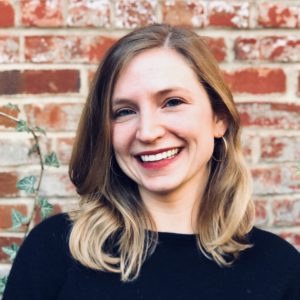 This month’s Industry Insider interview is with Emma Ledbetter, Editorial Director of Picture Books at Abrams Books for Young Readers. Why am I so stoked about this that I’m including a gif of a dancing Muppet here? It’s because she wowed the crowd at an SCBWI event in Orlando this
This month’s Industry Insider interview is with Emma Ledbetter, Editorial Director of Picture Books at Abrams Books for Young Readers. Why am I so stoked about this that I’m including a gif of a dancing Muppet here? It’s because she wowed the crowd at an SCBWI event in Orlando this past June, and yours truly was in the audience. And I mean wowed as in WOWed.
past June, and yours truly was in the audience. And I mean wowed as in WOWed.
I could say more, but let’s instead hear what her new colleague, Andrew Smith (senior VP and publisher of the kidlit division at Abrams), wrote about her in a November 2018 article for Publisher’s Weekly. “Emma’s editorial career includes an expansive and impressive array of engaging picture books that have earned countless stellar reviews and accolades, but most important, they’ve delighted and enlightened young readers. I’m thrilled that she will be bringing her keen eye and expert taste to Abrams, and I’m very excited about the contributions she’ll be making to our list.”
Gosh, that’s so nice that I’m blushing!
Need more, though? I’ll give you five additional Emma bio/career nuggets, then it’s interview time.
- She has a BA in Art History from Yale University.
- She had internships at Little, Brown, Nickelodeon, and
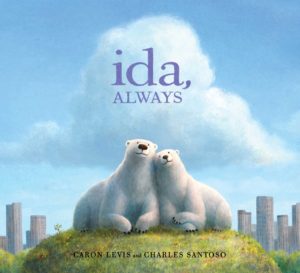 Nick Jr.
Nick Jr. - Her Twitter handle is indeed a shout-out to fans of Frances (the most famous badger in all of kidlit).
- She loves Edward Gorey.
- She edited the picture book Ida, Always by Caron Levis (illustrated by Charles Santoso).
Ready for the interview now? Onward!
- Abrams Books for Young Readers Website: www.abramsyoungreaders.com
- Twitter: @brdnjamforemma
- Pinterest: www.pinterest.com/emmaled/
RVC: How did someone studying Art History at Yale end up with internships at Nickelodeon and Nick Jr.? Did we almost lose you to an adjacent-but-not-quite-kidlit career?
EL: Ha! Actually, I was always interested in children’s entertainment—around high school, I dreamed of working at Pixar, and that interest led me to Nickelodeon. And in my art history major, I wrote my thesis about Little Golden Book illustration. So I was always trying to find the kid-angle while I was in college. I think it left some of my professors kind of confused.
RVC: Since I run into all kinds of art-loving students at Ringling College, I also try to introduce a kid-angle to their efforts, regardless of their major. Why not, right?
Let’s circle back to the presentation I mentioned in the bio that earned you the exceedingly rare OPB Muppets shout-out. One of the things I took away from that Orlando SCBWI talk is your sincere love for and appreciation of nonfiction picture books. What do you like so much about this sometimes-underappreciated type of book?
EL: First of all, thanks for your kind words about my presentation—it can be nerve-wracking up there! It’s interesting that my love of picture book nonfiction struck you, because I don’t usually think of myself as a nonfiction editor (I’d say about 80% of my list is fiction). What I DO love is nonfiction that is creative, fun, and/or unusual—in its subject, its writing style, its angle into the story, etc. Nonfiction that “reads like fiction.” I’m very selective with it. So you can be sure that if you see a nonfiction book I edited, it’s not just because I liked the topic—it’s because I found the approach particularly interesting or engaging.
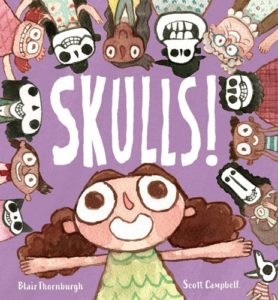 RVC: Speaking of engaging, one of the nonfiction examples you used in Orlando was Skulls! by Blair Thornburgh (illustrated by Scott Campbell). For those who missed your talk, would you sum up a few of the reasons that you pounced—editorially speaking—on that book submission?
RVC: Speaking of engaging, one of the nonfiction examples you used in Orlando was Skulls! by Blair Thornburgh (illustrated by Scott Campbell). For those who missed your talk, would you sum up a few of the reasons that you pounced—editorially speaking—on that book submission?
EL: #1, it made me LAUGH. OUT. LOUD. But it’s also extremely smart.
#2, I’d never seen anything like it before. It is completely fact-based and scientifically accurate; it’s also totally wacky, and not remotely dry. It’s kind of un-categorizable, actually.
#3, on reading Blair’s text, I could instantaneously picture what I wanted the book to look like (thank goodness Scott agreed and said yes!) The two of them knocked it out of the park!
RVC: A few of my creative writing students are interested in a career like yours. Let’s give it to them straight. What’s your day-to-day work like as an editor?
EL: I answer emails and go to meetings all day long, then go home to read and edit! (But some of those emails are really cool—like approaching an illustrator I love, or sending someone an offer. And some of those meetings are really fun—like digging into a sketch dummy with an art director, or presenting my books to get our in-house teams excited about an upcoming list.)
RVC: Writing those “I love you and your work!” emails can indeed by fun. But what’s the most difficult aspect of your work?
EL: Time management is a big one. I strongly dislike negotiating contract terms (though it needs to be done!) and evaluating submissions is actually really tough. I get so very many of them, and it’s never fun to send a rejection. It’s extra-hard when I fully see the merit in something and I really like it, but I just don’t have the space on my list, or I’m not 100% head-over-heels for it—only 99%.
RVC: Time and time again, I hear writers who lament how they wish they could do their own illustrations, like Jillian Tamaki or Sarah Williamson do. Make a case for the power of two creatives—the author + the illustrator—versus the all-in-one author/illustrator.
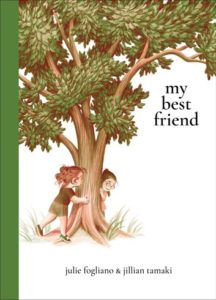 EL: Even some of the most talented and successful author-illustrators sometimes like to mix it up! I’ve seen an illustrator who writes her own stories fall in love with someone else’s text (like Jillian, who illustrated Julie Fogliano’s My Best Friend), and I’ve seen author-illustrators write a story that they think would be best served by an artist with a different point of view (like Tomie dePaola, who wrote In a Small Kingdom, which was illustrated by Doug Salati).
EL: Even some of the most talented and successful author-illustrators sometimes like to mix it up! I’ve seen an illustrator who writes her own stories fall in love with someone else’s text (like Jillian, who illustrated Julie Fogliano’s My Best Friend), and I’ve seen author-illustrators write a story that they think would be best served by an artist with a different point of view (like Tomie dePaola, who wrote In a Small Kingdom, which was illustrated by Doug Salati).
Illustrating or writing vs. illustrating and writing can be totally different creative processes, stretching and refreshing your brain. Having a separate illustrator can take your story in wonderful, exciting directions that you couldn’t even imagine when you wrote it. And sometimes, particularly if you don’t have an art background and haven’t spent a lot of time developing your artistic craft, not illustrating your own book is simply the best decision for making the best book possible.
RVC: What are your feelings on illustration notes from writers?
EL: I don’t mind them when they’re critical to explaining a certain part of the story that the text doesn’t describe; or (and use this one selectively!) if you have a brilliant idea for what a certain page might show, and you phrase it as a *light suggestion.* Before sending a manuscript to an illustrator, I will delete pretty much any art notes that don’t fall into these categories.
Once an illustrator takes on a text, remember that it is now 50% their book.
RVC: How long does it take an editor to get situated when they change houses? And how soon is too soon to send them work?
EL: When I moved to Abrams, I’d say I felt situated about six months in, and I’ve been growing more comfortable ever since. I think I’ll feel truly at home once I’ve experienced one full round from acquisition to publication—my first full list of books comes out in Spring 2020, I can’t wait! And I’ve been receiving submissions here (from agents) since…two weeks before I started at Abrams?!
So, fire away!
RVC: Last question for this part of the interview. What’s the biggest story in kidlit that no one’s talking about enough?
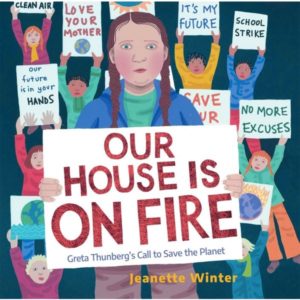 EL: Did you see how Jeanette Winter’s beautiful picture book about Greta Thunberg, Our House Is on Fire, went from initial conversation with her editor to published book in two months?? That is a feat surpassed only by Greta herself sailing across the ocean to speak at the U.N.!
EL: Did you see how Jeanette Winter’s beautiful picture book about Greta Thunberg, Our House Is on Fire, went from initial conversation with her editor to published book in two months?? That is a feat surpassed only by Greta herself sailing across the ocean to speak at the U.N.!
RVC: Greta is pretty amazing, and that amazingness is a great segue into the always-amazing conclusion of every OPB interview.
Cue the theme music. Open the velvet curtain. Turn on the spotlights. It’s time for … THE LIGHTNING ROUND! Zappy Qs and Zippy As, please. ARE YOU READY?
EL: Ready!
RVC: Most unexpected thing on your music playlist?
EL: Not sure if this is unexpected, but there sure is a lot of Hamilton on there…
RVC: “If I didn’t have a career involving books, I’d instead be _________”
EL: I’ll go with my childhood dream job: an elementary school art teacher!
RVC: Three picture book characters you’d love to have over for a dinner party?
EL: Frances the badger, of course; and let’s add in Lilly (and her Purple Plastic Purse) and Olivia. Dinner wouldn’t be boring, that’s for sure!
RVC: What’s your editorial superpower?
EL: I think I’m pretty good at finding the right illustrator to pair with a text! Also I have very colorful pens.
RVC: Best non-Abrams picture book you’ve read in 2019?
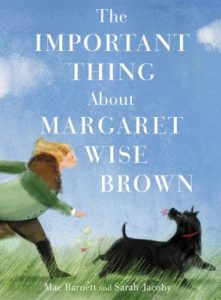 EL: Two came immediately to mind: I absolutely loved The Important Thing About Margaret Wise Brown and Small in the City.
EL: Two came immediately to mind: I absolutely loved The Important Thing About Margaret Wise Brown and Small in the City.
RVC: In five words or less, how do you measure success?
EL: Do it for the kids.
RVC: Thanks a bunch, Emma. It was indeed a pleasure getting to know you and your work a bit better!
EL: Thanks for having me, Ryan!

